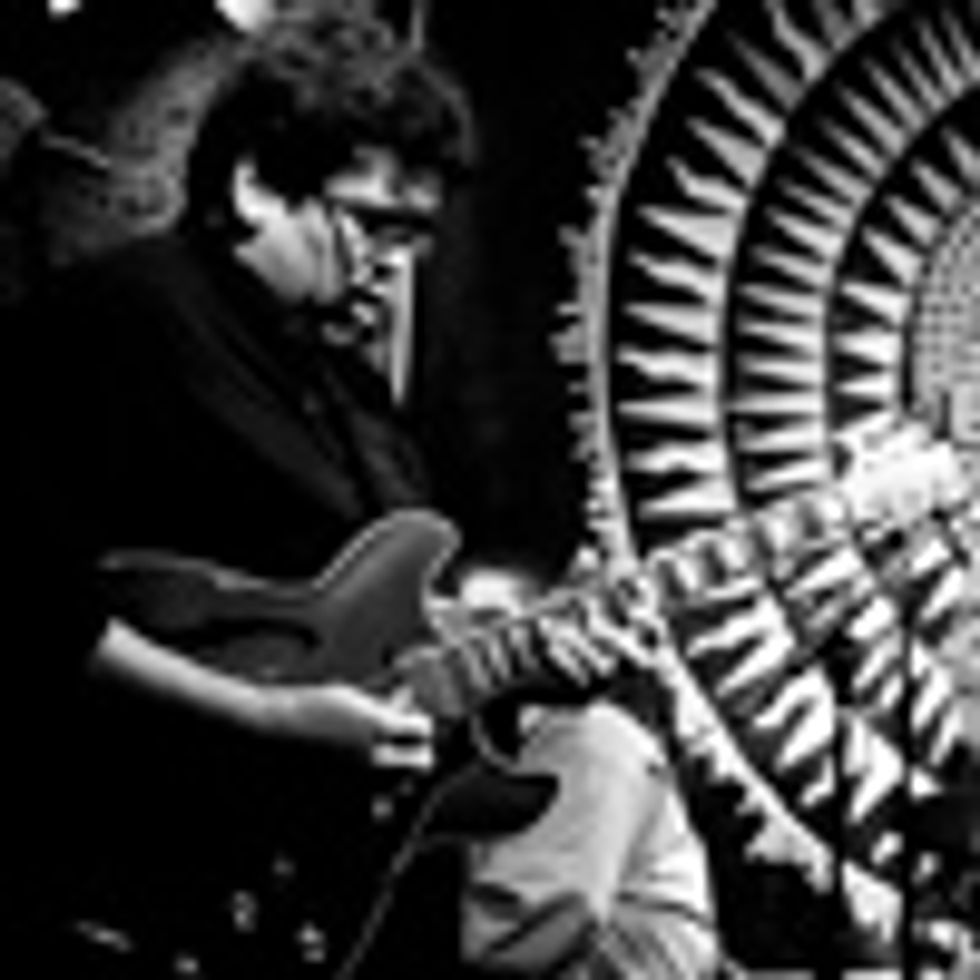| Chops: Intermediate Theory: Intermediate Lesson Overview: • Understand the basic concept of the diminished chord. • Develop lines using the half/whole diminished scale. • Learn how the #IV diminished chord works in a blues progression. Click here to download a high-resolution, printable PDF of the notation. |
In last month’s column we looked at variations on 8-measure blues progressions. A few of the progressions featured a passing diminished chord. Usually, this connected the IV chord back to the I chord by using a #IV diminished chord. This is a cool harmonic device that can be used both in 8- and 12-bar progressions.
This month we’re going to look at how to solo over the diminished chord. To keep things simple, all of the examples can be played over the four-measure phrase shown in Fig. 1. This could function as measures 5 through 8 in a twelve-bar blues or measures 3 through 6 of an eight-bar blues.
We use a D# diminished 7th arpeggio (D#–F#–A–C) in the second measure of Fig. 2. We only have four beats, so we’ll play eighth notes to connect from the D7 to the A7.

In Fig. 3 we exploit the fact that since each note in a diminished 7th arpeggio is a minor third apart, we can move different arpeggio fingerings by a minor third as well. In the second measure, the pattern begins on beat two with the triplet figure. We then slide that shape down to the second fret during the triplet on beat three to create a symmetrical feel that catches the ear. You may notice that my first arpeggio doesn’t even have a D# in it, but it puts me in position to play in my first position minor pentatonic scale. I also like to look at this as if I’ve moved from the first position A minor pentatonic to the fifth position A Major pentatonic fingering.
Fig. 4 is a half/whole diminished scale fingering used by jazz musicians to play over diminished chords. This scale is built the exact way it is named, it is a half step followed by a whole step. This is a symmetrical fingering. This means that every three frets it repeats. So, instead of starting this scale out of my A blues position I’m going to move it down two set’s of minor thirds, or six frets to A half whole. This puts it right in my A minor pentatonic position at the fifth fret.
Fig. 5 uses the half/whole scale to create a lick over the #IV diminished 7th chord. The thing I like most about using the half/whole diminished scale is that I can keep from sounding like I am playing clichés. I don’t always want it to sound like I’m playing diminished, or beckoning Karlos Borloff in a horror flick.
I hope you’ve enjoyed learning some cool diminished licks this month. Take your time with them and make sure to create a few of your own. The diminished ideas we’ve learned this month can be played over the second bar of the IV chord leading back to the I chord even if the #IV diminished isn’t being played. You can imply the harmony with these licks. Robben Ford uses this concept a lot. It’s a way of creating even more tension to then release back on the I chord. In the end, I want it sound bluesy, because that’s what I’m playing, the blues.
 Dennis McCumber has been a guitar instructor and performer
for more than 20 years. He holds a Bachelor’s degree in music
education from The College of Saint Rose.
Dennis performs
regularly in the New York City area with various rock, blues, and funk bands, and occasionally as a classical soloist.
In addition to performing, Dennis has been a middle school
music teacher in the Bronx for the past 12 years. While
teaching in the Bronx, he was given a guitar lab by VH1
Save the Music and a keyboard lab from the radio station
Hot97 Hip Hop Symphony. Dennis has been an instructor at
the National Guitar Workshop since 1996, where he teaches
Blues, Funk, and Rock. Find out more at dennismccumber.com.
Dennis McCumber has been a guitar instructor and performer
for more than 20 years. He holds a Bachelor’s degree in music
education from The College of Saint Rose.
Dennis performs
regularly in the New York City area with various rock, blues, and funk bands, and occasionally as a classical soloist.
In addition to performing, Dennis has been a middle school
music teacher in the Bronx for the past 12 years. While
teaching in the Bronx, he was given a guitar lab by VH1
Save the Music and a keyboard lab from the radio station
Hot97 Hip Hop Symphony. Dennis has been an instructor at
the National Guitar Workshop since 1996, where he teaches
Blues, Funk, and Rock. Find out more at dennismccumber.com.














![Rig Rundown: Russian Circles’ Mike Sullivan [2025]](https://www.premierguitar.com/media-library/youtube.jpg?id=62303631&width=1245&height=700&quality=70&coordinates=0%2C0%2C0%2C0)













